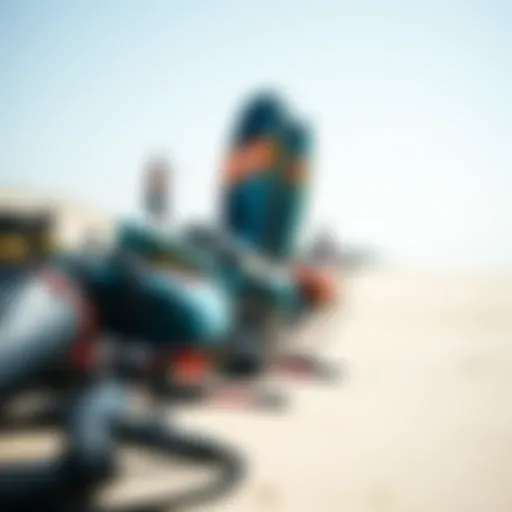Mastering Kiteboarding: The Role of Wind Dynamics
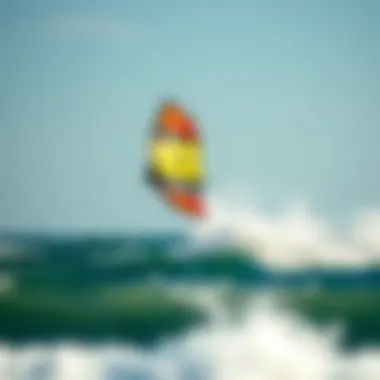
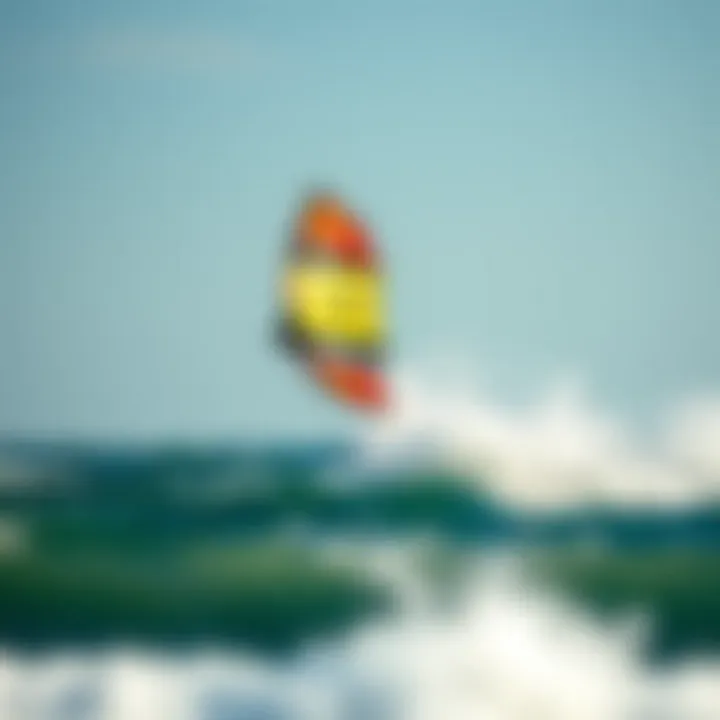
Intro
The world of kiteboarding intertwines the thrill of cutting through waves with the unpredictability of the wind. A kiteboarder’s success hinges not just on skill but also on understanding the dynamics of kite wind. From the gust that gives lift to the board beneath your feet to the relentless gales that can turn a joyful ride into a challenge, the nuances of wind patterns are essential to mastering the sport.
Navigating wind conditions requires more than just a surface-level grasp of meteorological principles. One must consider how the wind behaves across different terrains and how it interacts with natural and man-made features. This understanding can make the difference between a mediocre day on the water and an exhilarating experience filled with high jumps and smooth glides. Kiteboarding, in essence, is a dance with the wind—a skillful balancing act that combines physics, technique, and awareness.
This article aims to equip kiteboarding enthusiasts with a treasure trove of insights, exploring the fascinating interplay between wind and kiteboarding. From beginner techniques to advanced maneuvers, every kiteboarder should feel empowered to harness wind energy safely and effectively.
Techniques for Kiteboarding Enthusiasts
Beginner Techniques
For those stepping onto the water with a kite for the first time, understanding the wind’s behavior is crucial. Start by experimenting with different kite sizes based on the wind conditions and your weight. The general rule of thumb is that lighter winds call for a larger kite, while stronger winds dictate a smaller one.
- Learn to Read the Wind: Observing how the wind interacts with the water surface is key. Look for telltale signs like the direction of the ripples or how green seaweed sways in varying winds.
- Control Your Speed: Beginners should practice maintaining steadiness. Keep the kite low and move gradually to make small adjustments; this will help you feel the kite's pull without getting overwhelmed.
- Understand the Safety Systems: Familiarize yourself with your equipment's safety features. Knowing when and how to deploy them can prevent a mishap on the water.
Advanced Maneuvers
Once you have a handle on the basics, it’s time to explore more advanced kiteboarding techniques. These maneuvers not only enhance your skills but also provide the thrill many kiteboarders seek.
- Jumping: For those feeling confident, learning how to leap off the water is a natural next step. Timing is essential here; you want to pull on the back line just as the kite reaches the zenith of its window.
- Tricks and Spins: Once you've mastered jumping, you can start incorporating spins and flips. This not only adds flair to your riding but also helps you adapt to changing wind conditions rapidly.
- Riding Upwind: Improving your ability to ride upwind is crucial for maintaining your position and can significantly enhance your overall control. Continuous practice and wind awareness will aid in perfecting this skill.
"Mastering the elements is about grasping not just how to ride the waves, but how to dance with the wind itself through each gust and breeze."
Through these techniques, kiteboarders can embrace the challenges posed by wind dynamics and turn them into opportunities for adventure and growth on the water.
The Importance of Wind in Kiteboarding
Kiteboarding, as exhilarating and dynamic as it is, fundamentally relies on one critical element: wind. Without wind, kiteboarding would simply not exist. Understanding the significance of wind is not only essential for safety but is also paramount in enhancing one's performance and overall experience on the water. By honing in on the ways wind interacts with kites, enthusiasts can transform their time spent kiting into a feast of adventure and thrill.
Why Wind Matters
Wind serves as the lifeblood of kiteboarding. It is the invisible force that propels kiteboarders across the water, making it crucial to respect this component. Here are some key reasons why wind matters:
- Control and Stability: Having an understanding of wind dynamics allows kiteboarders to maintain better balance and control while navigating waves and gusts.
- Safety: Recognizing wind patterns can help kiteboarders identify dangerous conditions. For instance, strong offshore winds pose a significant risk as they can pull a rider further away from shore.
- Performance Improvement: Different wind conditions dictate how well a kite will perform. Knowledge of how to adjust techniques based on varying wind strengths can lead to an improved ride.
Moreover, kiteboarders who appreciate the nuances of wind can take advantage of its varying strengths and directions. By aligning themselves properly relative to the wind, they can maximize lift and minimize resistance, getting the most out of each session.
The Role of Wind in Kite Performance
The performance of a kite is heavily influenced by the wind at play. Factors such as wind speed and direction can drastically change the characteristics of a ride. Here's how wind shapes kite performance:
- Wind Speed: The strength of the wind informs the size of the kite. In light wind conditions, kiteboarders typically favor larger kites that can catch more air. Conversely, higher wind speeds call for smaller kites that offer better control and less overpowering power.
- Angle of Attack: The angle at which the kite faces the wind directly impacts lift. A well-angled kite can capture wind efficiently, boosting the rider upward. Adjusting this angle based on wind conditions is key to optimizing both height and distance traveled.
- Dynamic Responses: Experienced kiteboarders can leverage shifts in wind patterns to execute tricks or maneuvers. Understanding how to react to sudden gusts or lulls in wind can lift an average performance to extraordinary heights.
"Mastering the wind is equivalent to mastering kiteboarding itself. Those who listen to the whispers of the breeze can turn mere rides into breathtaking journeys."
In summation, the wind is not merely a factor in kiteboarding; it's the driving force that defines the sport. So, whether you are a beginner or a seasoned rider, grasping the intricacies of wind behavior can upgrade your sessions and keep you riding safely. Mastering the wind not only means enjoying the thrill it brings but also knowing that your safety hangs in the balance.
Understanding Wind Patterns
Understanding wind patterns is a fundamental aspect of kiteboarding, as they play a pivotal role in determining both the safety and enjoyment of your kiteboarding experience. Being adept at reading and interpreting these winds can elevate a rider's skills and adaptability in various situations. Without a grasp of wind dynamics, even the most skilled kiteboarders can find themselves struggling against unpredictable gusts or unfavorable conditions. This section will explore the nuances of wind patterns and their implications, ultimately guiding kiteboarders on how to navigate through different wind scenarios effectively.
Types of Wind Patterns
Wind isn't just a simple breeze; it presents itself in various forms, each with distinct characteristics that can affect kiteboarding conditions. Let's delve into three primary types of wind patterns commonly encountered:
Offshore Winds
Offshore winds blow from the land towards the sea. These winds can be particularly appealing for kiteboarders due to their consistency and often predictable behavior. The key characteristic of offshore winds is that they typically provide a smooth flow of air without the interference of coastal obstructions, such as trees or buildings.
One benefit of offshore winds is that they frequently offer ideal conditions for freeride or freestyle kiteboarding. The absence of gusts caused by land structures means that riders can focus on tricks without worrying about sudden changes. However, a notable drawback is that these winds can often lead to conditions away from safety zones; should an emergency arise, the rider may find themselves being taken farther from shore, complicating rescue situations. Therefore, while offshore winds can enhance the kiteboarding experience, caution is advised.
Onshore Winds


Onshore winds, as the name suggests, blow from the sea towards the land. These winds are typically stronger and can make for exciting rides, as they often generate larger waves. The defining feature of onshore winds is their ability to create unpredictable shifts, driven by local geography and changing weather.
For kiteboarders, onshore winds are often considered beneficial due to the proximity they keep riders to the coastline, which can enhance safety. However, this wind pattern also brings challenges; the breaking waves combined with the wind can lead to a choppy riding surface, requiring more skill to navigate. Riders need to be well-prepared and ready to adapt their techniques to maximize the thrill while managing any risks.
Cross-Shore Winds
Cross-shore winds blow parallel to the coastline and can vary in intensity throughout the day. A unique aspect of cross-shore winds is their versatility. They can suit various styles of riding and can lead to impressive conditions, especially because they often provide consistent pressure on the kites. The ease of transitioning between tricky maneuvers is one of the primary advantages of cross-shore winds.
Yet, the complexity of these winds shouldn't be underestimated. Depending on their strength and timing, cross-shore winds can create challenging conditions for both beginners and advanced riders. Waves might become inconsistent, and pinpointing the optimal riding angle can take practice to master. As with any wind pattern, understanding how to work with cross-shore winds requires practice and a sound knowledge of conditions.
How Geography Influences Wind Behavior
Location plays an indisputable role in shaping wind behavior. Various geographical features like mountains, valleys, and bodies of water create unique microclimates that affect how wind flows and interacts. For kiteboarders, it’s vital to consider these influences when selecting a spot to ride.
For instance, mountains might block or redirect incoming winds, leading to unexpected gusts or lulls, while coastal areas could funnel wind differently due to proximity to water. Being aware of local geography allows riders to better anticipate wind changes, leading to safer and more enjoyable experiences on the water.
Understanding wind patterns and behavior not only sharpens one's riding skills but also cultivates a deeper appreciation for the natural elements that make kiteboarding so exhilarating. By gaining this insight, kiteboarders will be better positioned to harness the wind effectively, ensuring more rewarding sessions on the water.
Measuring Wind Speed and Direction
In the dynamic world of kiteboarding, understanding the wind is like finding the pulse of the ocean. Measuring wind speed and direction becomes critical not just for performance, but also for safety. Ignoring these data can turn a joyous ride into a perilous episode. Just as a seasoned sailor wouldn’t set out without checking the weather, a kiteboarder needs to be aware of the wind’s behavior to achieve a rewarding experience on the water. Thus, the necessity for precise measurement tools and the ability to interpret the information they provide cannot be overstated.
Essential Tools for Assessment
Anemometers
Anemometers serve as the eyes and ears for kiteboarders, shedding light on wind speeds, which can vary dramatically in different environments. The unique ability of an anemometer to measure speed makes it indispensable, as knowing the wind speed helps kiteboarders select the right equipment and adapt their techniques accordingly. The most common type, the cup anemometer, features rotating cups that catch the wind. When the wind hits, the cups spin, and the speed can be calculated based on how fast they rotate.
One key characteristic of anemometers is their accuracy; they typically provide data that is close to real-time, which is crucial for making split-second decisions on the water. However, one disadvantage is that they can be somewhat bulky and unwieldy to transport. Yet, their benefits—especially in gusty conditions—make them a popular choice among kiteboarders, enabling thorough wind assessments and allowing riders to get out and enjoy the conditions safely.
Wind Vanes
Wind vanes are another essential tool, particularly useful for gauging wind direction. Unlike anemometers, wind vanes don’t measure speed, but they excel in giving kiteboarders a clear picture of how the wind flows within a specific area. This can help riders position themselves appropriately to maximize lift, ensuring a smoother ride. A key characteristic of wind vanes is their simple yet effective design, consisting of a rotating arm mounted on a vertical pole that points where the wind is blowing from.
One unique benefit of wind vanes is their ease of installation; they can be secured quickly on a pole or integrated into existing setup easily. However, they do have limitations—if the wind is light, they may not respond as quickly, leading to lagging information. Despite this, understanding wind direction is vital, helping riders to avoid dangerous areas and optimizing their techniques when out on the water.
Interpreting Wind Data
Once armed with measurement tools, the next step involves interpreting the wind data they produce. Understanding wind speed and direction not only guides kiteboarders in choosing their kites but also in planning their routes and maneuvers. For example, a north-east wind may signal ideal conditions for certain locations, while a south-west wind could indicate gusty weather more suited for experienced riders.
Additionally, wind data can change quite rapidly, and being able to read the signs can be a game changer. Kiteboarders need to stay vigilant and flexible, watching the water’s surface for clues like ripples or waves that indicate stronger winds.
In sum, mastering the tools and knowledge for measuring wind speed and direction is akin to acquiring a compass for navigating the vast sea of kiteboarding. When riders grasp the nuances of these elements, their experiences on the water become not only safer but also infinitely more enjoyable.
"In kiteboarding, understanding wind is not just advantageous; it's essential. Every gust tells a story that can make or break a ride."
For more information on wind and its effects on watersports, consider checking out resources from the National Weather Service or the American Kitefliers Association.
The Physics Behind Kiteboarding
Understanding the physics behind kiteboarding is like piecing together a complex puzzle. The relationship between the kite and the wind is not only fascinating, it’s vital for any kiteboarder aiming for success on the water. Knowledge of aerodynamics can be the difference between a smooth glide and a faceplant in the ocean. Everything from lift and drag forces to the materials of the kite influence performance, and knowing how to navigate these forces can provide an exhilarating experience rather than a precarious one.
Equipping oneself with a robust grasp of the physics also promotes safety and informed decision-making. Determining when and where to kite is essential in situations where the wind can rapidly change, affecting not only one’s enjoyment but also safety. In a field that thrives on mastery of the elements, getting to grips with the underlying science makes for a more skilled and cautious kiteboarder.
Aerodynamics of Kites
When discussing kiteboarding, aerodynamics is at its core. A kite transforms wind energy into lift, allowing riders to soar across water. Aerodynamics is the study of how air interacts with moving objects, and in kiteboarding, this interaction determines performance.
The shape of the kite plays a pivotal role. Kites are typically designed with a curve that enables airflow to generate lift. As wind passes over the surface, it moves faster over the top compared to the bottom. This difference in velocity creates lower pressure above the kite, causing it to rise. Simply put, the faster air over the top leads to a pressure difference that lifts the kite into the sky. This is fundamentally how kites operate, leveraging lift to maximize performance.
The configuration of the kite also matters. The bridle system adjusts the angle at which the kite meets the wind, affecting how efficiently it performs in different conditions. For example, a flatter kite plays better in high winds while a more pronounced arc helps in lighter breezes.
Understanding these nuances in aerodynamics not only helps in selecting the appropriate kite, but also in modifying technique based on conditions.
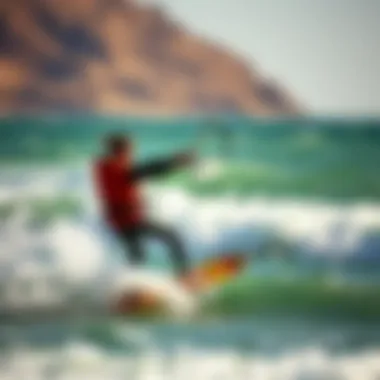
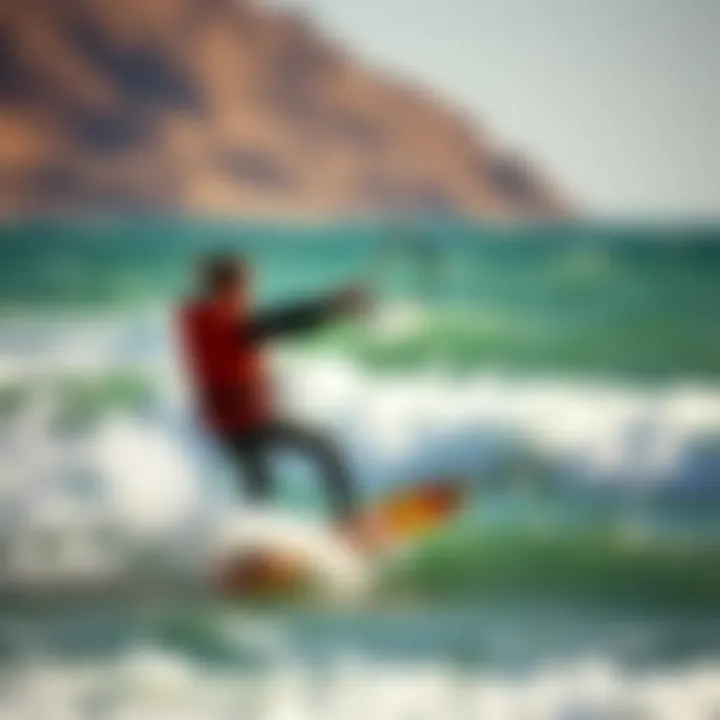
Lift and Drag Forces
In the world of kiteboarding, lift and drag are two forces that dance together to create the thrill of the sport. Lift is what keeps the kite aloft, while drag can hinder performance if not managed wisely. It can be helpful to think about them as two sides of the same coin.
- Lift: The force generated as wind moves over and under the kite surface. The kite's angle affects the amount of lift produced; a steeper angle creates more lift but potentially increases drag, influencing speed.
- Drag: This is the resistance faced by the kite as air flows over it. High drag can slow a kite down and make controlling it much more difficult. A proficient kiteboarder aims to maximize lift while minimizing drag.
It’s akin to fine-tuning a machine; understanding how to balance these forces lets riders effectively maneuver, jump, and even navigate tricky wind conditions. Kiteboarders often learn to lean into the kite during high lift scenarios or adjust their body position when drag becomes problematic.
"Mastering the interaction between lift and drag can ultimately enhance a kiteboarder's experience and performance on the water."
Going beyond the basics of lift and drag is essential for serious kiteboarders. Tuning various components of the setup can lead to improved performance. Consider experimenting with different kite sizes depending on wind conditions, as well as adjusting riding posture to shift the balance of forces during runs. Having a deeper understanding of these physical forces can not only make kiteboarding more enjoyable but also significantly enhance safety on the water.
Choosing the Right Kite for Wind Conditions
Selecting the right kite for the wind conditions is essential in kiteboarding. It can mean the difference between a thrilling ride or a harrowing experience. Kiteboarding isn't just about having fun on the water; it requires an understanding of the winds that propel kite and rider. You don’t want to find yourself underpowered or overpowered, as either scenario can lead to precarious situations. Understanding how to choose the right kite involves considering various factors, such as wind speed, kite type, and your own skill level. In this section, we’ll break down the critical elements to keep in mind when making your choice, ensuring a better connection with the wind and an elevated level of satisfaction.
Factors to Consider
When assessing which kite to use based on wind conditions, several factors come into play:
- Wind Speed: The velocity at which the wind blows critically influences your choice. Light winds typically require larger kites, while stronger winds call for smaller ones. You’ll want to check gusting patterns and choose wisely.
- Kite Type: Different kite designs serve distinct purposes. For example, a C-kite has a different performance profile compared to a bow kite. Understanding these differences allows for better alignment with your riding style and conditions.
- Rider Experience: If you’re just starting, opting for a kite that's more forgiving in a given wind scenario is wise. Experienced riders, however, can handle a variety of kites under changing conditions. Know your ability before making a selection.
- Water Conditions: Choppy waters may affect stability, leading to the need for kites that can handle turbulence better. Flat water, on the other hand, can enhance performance with various types of kites.
Making an informed decision about the right kite requires more than a quick glance at the wind speed; it’s about having a deeper understanding of how all these factors interplay in practical scenarios.
Kite Size and Performance
The kite's size directly impacts its performance, not only in terms of speed but also in handling. Generally speaking, larger kites catch more wind, which can be an advantage in lighter conditions. However, they may become too overpowering when the wind picks up. Conversely, smaller kites are more manageable in stronger winds but may leave you underwhelmed in lighter settings.
Consider the following aspects about kite size and its impact on performance:
- Aspect Ratio: A kite with a higher aspect ratio travels faster and has better upwind performance. This is essential when kiteboarding in variable winds where direction changes frequently.
- Bar Pressure: Larger kites usually create more bar pressure, which affects how responsive the kite feels.
- Wind Range: Each kite has a recommended wind range that should never be ignored. Always refer to the manufacturer’s specifications to ensure you’re choosing a size suited to the wind.
Understanding kite size in relation to wind performance can empower kiteboarders to make shrewd choices suited to various conditions, ultimately leading to a more exhilarating ride.
"Choosing the right kite is like matching the perfect ingredients in a recipe; it makes all the difference for the final experience."
In summary, making an astute choice when selecting your kite based on the wind conditions can vastly enhance your kiteboarding experience. Whether you’re floating serenely on light winds or slicing through strong gusts, the right kite equips you to master the elements.
Techniques for Harnessing Wind Effectively
In the world of kiteboarding, mastering the art of harnessing wind is paramount. It’s not just about getting on the board and flying a kite; it’s about understanding how to use the wind's power to your advantage. Kiteboarding is an intricate dance between environmental forces and kite control techniques. By learning how to position, angle, time, and control your movements in sync with the wind, you’ll significantly enhance your ride, boost your performance, and ensure you’re riding safely.
Positioning and Angling
Positioning your kite appropriately in relation to the wind is crucial for optimal performance. Think of the wind as a river, and your kite and board are boats navigating through it. A well-placed kite can harness wind energy efficiently, pulling you smoothly across the water.
Key Considerations for Positioning:
- Wind Window: The area where your kite can operate ranges from straight up at 12 o'clock to directly behind you at 6 o'clock. Positioning the kite in different zones of this window influences speed and lift.
- Angles Matter: Angling your kite properly is vital. If your kite is too low, it might generate drag instead of lift. Conversely, a kite too high might stall out. Finding that sweet spot is the key.
- Body Position: Your own body placement influences how the kite reacts. Leaning back can drive the kite further into the wind, increasing tension and speed.
By focusing on these elements, you can adapt to changing wind conditions, improving your ability to jump, turn, and maintain stability on the water.
Timing and Control
The element of timing plays a vital role in kiteboarding. It is akin to the rhythm in a dance—every move must be synchronized with the wind. Effective timing ensures that your maneuvers correspond with gusts and lulls, allowing you to take full advantage of the wind's energy.
Key Elements of Timing and Control:
- Responding to Wind Changes: Being in tune with the wind means reacting quickly to sudden shifts. Trust your gut—if you feel a gust, position your kite to capture that energy right away.
- Pumping Technique: Sometimes, to get that extra boost, you need to pump the kite. This involves timing your movements with the wind's force, essentially working with the kite rather than against it.
- Controlled Descent: While performing tricks, the descent phase requires precise timing. You need to control how you drop back to the water, ensuring you don’t crash or lose momentum.
"Success in kiteboarding is akin to playing the saxophone—it's all about finding your rhythm and holding onto it while weaving through the notes of the wind."
Mastering these techniques of positioning and timing is essential for any kiteboarder aiming to harness the wind effectively. Whether you're catching the perfect wave or soaring through the air, attention to wind dynamics, along with your body movements, will keep you riding the extraordinary currents of kiteboarding.
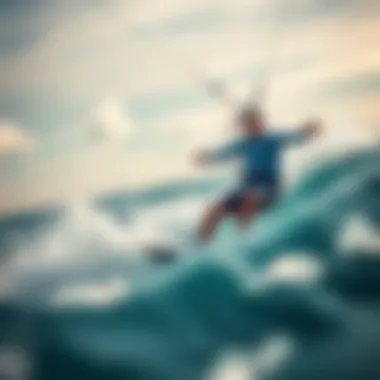
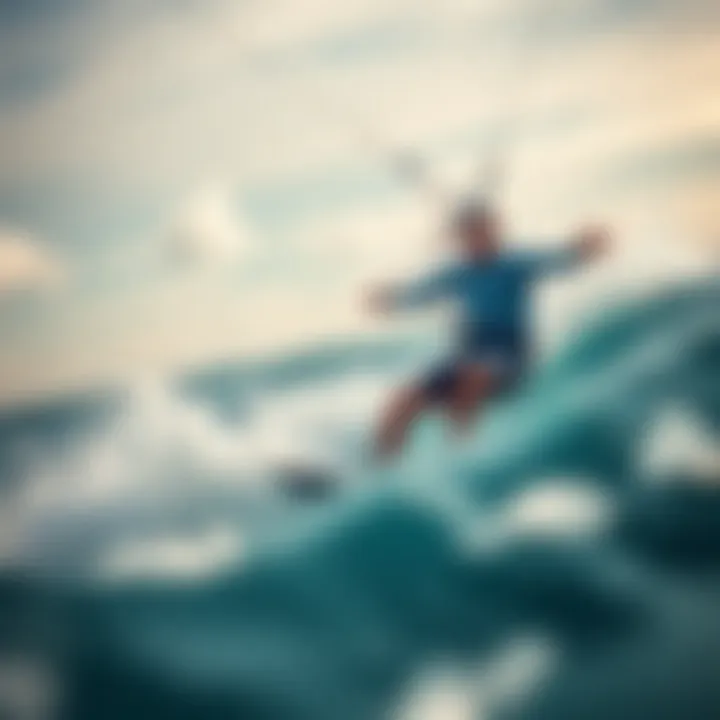
Safety Considerations Related to Wind
Understanding the dynamics of wind in kiteboarding is not just about riding the waves and catching air. It crucially involves safety considerations that can mean the difference between a thrilling day on the water and a disastrous one. Having a firm grasp on what constitutes safe wind conditions helps kiteboarders make informed choices that prioritize their well-being and that of others around them. Risk management is a key pillar in the sport, and knowledge is a kiteboarder’s best friend.*
Identifying Dangerous Wind Conditions
When out on the water, recognizing dangerous wind conditions can be the first line of defense against accidents. A few factors to watch closely include:
- Wind Speed: Rapid increases in wind speed can signal impending danger. Be wary of sudden gusts that may exceed your skill level or your gear’s capability.
- Wind Shifts: Changes in wind directions can create unpredictable challenges. Situational awareness is key, especially if you notice a wind shadow or turbulence caused by obstacles like buildings or trees.
- Wave Behavior: High winds tend to create larger, choppier waves that can impact your ability to control your kite and maintain balance. Always pay attention to how the waves are reacting to the wind.
- Storms and Weather Systems: Keep an eye on the sky. Darkening clouds, sudden temperature drops, or changes in bird activity can indicate developing storms that bring strong winds and should be avoided.
When in doubt, it’s always better to stay ashore than risk facing dangerous conditions. Knowledge is power, particularly in recognizing hazards before they escalate.
Emergency Procedures During High Winds
If caught in high winds despite your best efforts, having a well-practiced emergency procedure can serve you well. Here’s what to do:
- Get Low: Lower your center of gravity to maintain control. This not only helps you stay on your board but also minimizes the kite’s lift, reducing any potential for a sudden flight or loss of control.
- Depower Your Kite: Use the trim straps or depower system to reduce the kite’s power as much as possible. This gives you back some control over the situation, allowing you to work your way to safety.
- Assess Your Surroundings: Quickly look around. Can you ride back safely? Are there obstacles to avoid? Make decisions rapidly, and don't hesitate to call for help if needed.
- Water Exit Protocol: Know how to safely exit the water if conditions worsen. This might mean heading to the nearest land, signaling for assistance, or using any escape route.
- Practice Rescues: Regularly practicing rescues with friends can prepare you for unexpected situations. Understand the rescue signals and actions to take if someone else is in trouble.
"Safety is not just a priority, but a practice. Know the wind, respect it, and you will ride it rather than be ridden by it."
By developing a solid grasp of these emergency procedures and honing them in practice sessions, kiteboarders ensure that they can respond effectively to unexpected changes in the wind. After all, peace of mind is invaluable when you're out there riding the elements.
Kiteboarding Locations: Wind Variability
Kiteboarding is a sport heavily influenced by wind conditions, making the choice of location paramount for enthusiasts. Understanding the variability of wind in different locales can greatly enhance the kiteboarding experience. Each spot not only has its own unique wind patterns but also brings along specific challenges and benefits that can shape a session, from how fast you zip across the water to how much control you have over your kite. Knowing these factors can mean the difference between a frustrating day floundering around and a thrilling adventure soaring through the air.
A favorable location with dependable wind conditions can draw kiteboarders like bees to honey, offering a consistent environment for practice and performance. It’s essential to not just rely on fortunate weather but to dive deeper into what makes each spot tick when it comes to wind behavior.
Global Destinations with Consistent Wind
When we cast our nets far and wide, several global kiteboarding destinations emerge with a reputation for consistent wind patterns. These places attract not just the seasoned riders but also newbies eager to improve their skills.
- Cape Town, South Africa: Renowned for its strong, steady winds, especially during the southeastern trade wind season, this location is often buzzing with kiteboarding activity. The summer months from November to March see winds that can reach upto 30 knots, creating thrilling conditions for adventurers.
- Maui, Hawaii: The south shore of Maui is like riding on a cascading tidal wave of wind. Trade winds blow steadily throughout the summer, often providing wind speeds that thrill both the weekend warrior and the pro alike.
- Tarifa, Spain: Often referred to as the wind capital of Europe, Tarifa benefits from the convergence of two distinct winds, the Levante and Poniente. This results in frequent and reliable wind, drawing kiteboarders from all over the continent.
Determining the right time to visit these places can be a game-changer. Each destination not only has its prime kite seasons but also varying wind conditions that cater distinctively to the needs of kiteboarders.
Local Spots and Their Wind Conditions
Local kiteboarding spots may not have the allure of global hot spots but often provide reliable wind for enthusiasts. Here are a few resonating examples where wind conditions can fluctuate from spot to spot:
- Lake Michigan, USA: The wind can be capricious here. Locations such as the North Shore deliver consistent, steady winds while areas around the southern shores can often be more unpredictable. Kiteboarding here requires knowledge of local weather patterns and an understanding of when to head out.
- Long Island, New York: Depending on the specific beach—whether it’s Jones Beach or the more secluded spots—the wind can vary widely. The onshore winds can sometimes be ideal for beginners, while more experience kiteboarders can chase the robust offshore breezes that come in at times.
- Seychelles: Not all local spots are created equal. Here, the trade winds are generally reliable during certain months. Although quite good year-round, being attuned to sea and seasonal patterns will enhance one’s riding experience.
In essence, the ardent kiteboarder should strive to familiarize themselves not just with the general wind conditions across different sites but also delve into the nitty-gritty details. Knowledge of these specifics, like the presence of obstacles such as buildings or trees, can directly impact wind behavior, thus affecting performance.
"The right conditions can transform an average session into something unforgettable; every breeze offers a chance for exploration. "
Kiteboarding is about more than just the board and kite; it's fundamentally about the winds that propel you. Taking the time to understand and experiment with the wind variability at different locations can lead to many more thrilling rides and enjoyable experiences on the water.
For further insights into global kiteboarding spots and wind patterns, you can check resources such as Kiteboarding Wiki, or the Kiteboarding Community on Reddit.
Finale: Mastering Kite Wind for Optimal Experience
In the world of kiteboarding, understanding the intricacies of wind dynamics is not just advantageous; it's essential. The relationship between a kite and the wind can be thought of as a dance. When synchronized, it leads to an exhilarating experience. However, without a grasp of the wind's behavior, one might find themselves struggling against the current forces. This section aims to crystallize key takeaways that epitomize the essence of mastering the wind for kiteboarding.
Recapping Key Insights
The journey through this article has unveiled a tapestry of knowledge, each thread contributing to a deeper understanding of kite wind dynamics. Here are some of the pivotal points:
- Wind Significance: Wind isn’t just a factor but the driving force behind kiteboarding. Grasping its behavior enables better control and performance on the water.
- Variety of Wind Patterns: Recognizing different types of wind, like offshore or onshore, shapes the choice of location and technique.
- Instruments for Measurement: Using devices like anemometers and wind vanes can help kiteboarders gain insights into wind speed and direction.
- Physical Forces: Understanding aerodynamics, lift, and drag applies directly to kites' performance, impacting dynamics significantly.
- Safety First: Knowledge of dangerous wind conditions and having emergency procedures can be the difference between a thrilling day and a calamitous one.
- Kite Selection is Crucial: Choosing the appropriate kite corresponds directly to wind conditions, creating a harmonious synergetic effect that enhances the overall experience.
- Location Matters: Different venues have unique wind profiles, requiring local knowledge for optimal kiteboarding.
Being aware of these insights allows kiteboarders not only to master their craft but also to respect the elements they work with.
Future of Kiteboarding and Wind Research
As kiteboarding evolves, so does the understanding of wind dynamics. Research in this field continues to advance, tapping into insights from meteorology and aerodynamics. Here’s what might lie ahead:
- Enhanced Technology Integration: Future kiteboards may integrate advanced telemetry systems that can provide real-time information on wind conditions and techniques to maneuver effectively.
- Global Wind Data Networks: Collaborations among kiteboarding communities worldwide may enable the creation of wind data sharing networks. This would allow kiteboarders to access and contribute to live updates about local conditions.
- Sustainable Practices: As environmental consciousness grows, kiteboarding can play a role in promoting sustainable practices that harmonize with nature. Understanding wind not only helps in performance but also in protecting ecological landscapes that support the sport.
- Advanced Training and Simulation: The development of more sophisticated training programs, using virtual simulation technologies to mirror wind conditions and responses could enhance learning experiences for kiteboarding enthusiasts.
- Focus on Safety Innovations: The industry may witness advancements in safety gear and protocols, supported by emerging technologies that ensure safety while navigating challenging wind conditions.
In summary, mastering kite wind is not merely about harnessing energy; it’s about crafting a more profound symbiotic relationship with nature. As kiteboarders become more attuned to wind dynamics, the collective experience on the water is poised to become safer, more enjoyable, and deeply connected to the environment in which this thrilling sport thrives.













